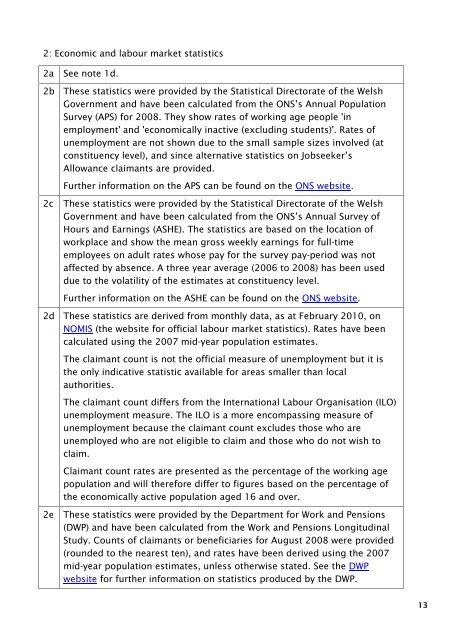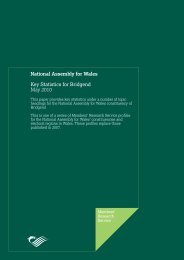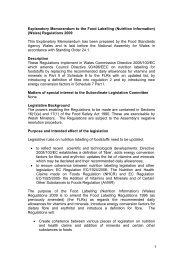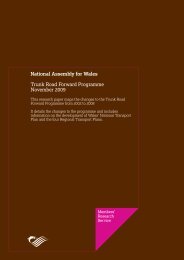Key Statistics for Caerphilly - National Assembly for Wales
Key Statistics for Caerphilly - National Assembly for Wales
Key Statistics for Caerphilly - National Assembly for Wales
- No tags were found...
You also want an ePaper? Increase the reach of your titles
YUMPU automatically turns print PDFs into web optimized ePapers that Google loves.
2: Economic and labour market statistics2a See note 1d.2b These statistics were provided by the Statistical Directorate of the WelshGovernment and have been calculated from the ONS’s Annual PopulationSurvey (APS) <strong>for</strong> 2008. They show rates of working age people 'inemployment' and 'economically inactive (excluding students)'. Rates ofunemployment are not shown due to the small sample sizes involved (atconstituency level), and since alternative statistics on Jobseeker’sAllowance claimants are provided.Further in<strong>for</strong>mation on the APS can be found on the ONS website.2cThese statistics were provided by the Statistical Directorate of the WelshGovernment and have been calculated from the ONS’s Annual Survey ofHours and Earnings (ASHE). The statistics are based on the location ofworkplace and show the mean gross weekly earnings <strong>for</strong> full-timeemployees on adult rates whose pay <strong>for</strong> the survey pay-period was notaffected by absence. A three year average (2006 to 2008) has been useddue to the volatility of the estimates at constituency level.Further in<strong>for</strong>mation on the ASHE can be found on the ONS website.2d These statistics are derived from monthly data, as at February 2010, onNOMIS (the website <strong>for</strong> official labour market statistics). Rates have beencalculated using the 2007 mid-year population estimates.The claimant count is not the official measure of unemployment but it isthe only indicative statistic available <strong>for</strong> areas smaller than localauthorities.The claimant count differs from the International Labour Organisation (ILO)unemployment measure. The ILO is a more encompassing measure ofunemployment because the claimant count excludes those who areunemployed who are not eligible to claim and those who do not wish toclaim.Claimant count rates are presented as the percentage of the working agepopulation and will there<strong>for</strong>e differ to figures based on the percentage ofthe economically active population aged 16 and over.2e These statistics were provided by the Department <strong>for</strong> Work and Pensions(DWP) and have been calculated from the Work and Pensions LongitudinalStudy. Counts of claimants or beneficiaries <strong>for</strong> August 2008 were provided(rounded to the nearest ten), and rates have been derived using the 2007mid-year population estimates, unless otherwise stated. See the DWPwebsite <strong>for</strong> further in<strong>for</strong>mation on statistics produced by the DWP.13
















